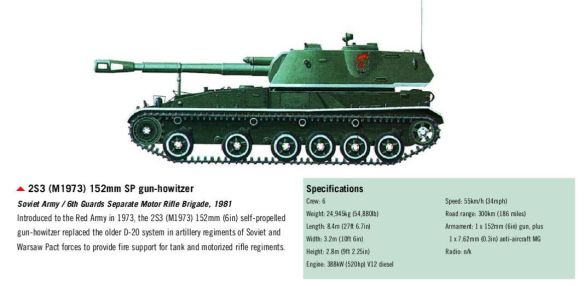While the tank became the public and political symbol of an army’s military prowess, overshadowing other battlefield weapons systems, within armies the importance of the artillery arm remained undiminished and, despite the advent of missiles and rockets, the gun remained the weapon of choice in the tactical battle.fn1 Provided targets were within range, guns were capable of producing extremely accurate and very destructive fire at virtually any spot selected by battlefield commanders. Further, artillery command-and-control systems enabled the guns to switch targets quickly and to increase the weight of fire by bringing additional batteries into action as required.
Artillery was of great importance in the Second World War, and this continued in the many smaller wars between 1945 and 1990, when the tactical value of artillery was demonstrated repeatedly, although never more convincingly than at the Battle of Dien Bien Phu during the First Indo-China War. During that prolonged siege, which lasted from December 1953 to May 1954, Viet Minh artillery occupied the hills overlooking the French base and from there they totally dominated the battlefield, closed the airfield, cut off supplies, and eventually bludgeoned the garrison into defeat.
In the early 1950s there were only a small number of self-propelled guns, all in open mounts on converted tank chassis, which supported armoured divisions in some armies (e.g. the British and US). The great majority of guns were wheeled pieces, towed either by a specially designed artillery tractor or, in some cases, by an ordinary general-purpose truck. At a US army conference held in Washington in January 1952 it was decided that the speed of modern warfare was increasing to such an extent, particularly with the infantry planning to be mounted entirely in armoured personnel carriers, that wheeled guns would no longer be able to keep up with the speed of movement. Also, the threat of nuclear weapons made it necessary to place the crews inside closed gun-houses (turrets) for protection. Furthermore, tracked vehicles were more capable of moving into temporary fire positions, getting into and out of action quickly, since there was no need to separate the gun from its tractor and set it on a base-plate. Then, after firing, they could move out rapidly – the so-called ‘shoot-and-scoot’ tactic – before enemy artillery could determine the source of the rounds and fire a counter-battery mission.
Soviet artillery had established an awesome reputation during the Second World War, but for the next two decades it experienced a conservatism unusual in the Soviet armed forces, which not only adhered to towed artillery, but also invariably deployed it in rows of six guns in uncamouflaged fire positions. Well-established Second World War guns therefore remained in service throughout the 1950s, and their replacements in the 1960s were also towed. It was only in the 1970s that self-propelled guns came into service, in which existing tracked chassis were matched to modified versions of existing guns, producing systems of 122 mm, 152 mm and 203 mm calibre. Although long overdue, these proved to be of excellent quality, with the usual Soviet combination of practical design, simplicity and long range, and caused considerable alarm in the West.
Czechoslovakia made a notable contribution to artillery design with its DANA system, which entered service in 1981. This featured a 152 mm gun in a split turret mounted on a modified 8 × 8-wheeled truck chassis. Although the wheels reduced its cross-country capability in comparison with a tracked vehicle, its performance was more than adequate for service in central Europe with its excellent road systems, and any tactical disadvantages were offset by its high road speed, long road range, considerably reduced capital cost, and ease of maintenance.
As with tankmen, gunners pursued the goal of first-round accuracy. Accuracy on target depended upon knowing the precise location of the guns, and manual methods of surveying gun positions gave way to much faster and more accurate electronic systems. In addition, movements became so frequent and time in any one position so brief that the traditional method of ascertaining meteorological conditions by visual and manual methods was no longer adequate and fully automated systems were introduced.
The introduction of SP guns with the crew housed in a turret meant that visual methods of control on the gun position were superseded by radio. Ever-expanding artillery communication systems also enabled artillery commanders to exercise much greater co-ordination and control of their units, and to respond much more rapidly to requests for fire support. Many national artillery arms were also quick to latch on to the potential of computerized fire-control systems.
Counter-Battery fire
Every military system inevitably preys on its own, and, as artillery became more effective, so too did the duel between artillery systems (known as ‘counter-battery’ fire) intensify. In the early 1950s there were two, fairly primitive, methods of locating enemy artillery. One used analysis of craters to estimate the direction and range of the gun. The other, called ‘sound ranging’, used sensitive microphones placed along a line (the ‘sound base’) and connected by radio; the sound of gunfire was detected by operators, who used the time of detection at the different microphones to compute the point of origin.
In the 1970s, however, the scale and efficiency of Soviet artillery systems, coupled with the ever shorter time spent in any one position, forced NATO to develop more accurate, more rapid and less manpower-intensive systems, such as the US army’s Firefinder, which consisted of two radars: one to detect mortars, the other to detect guns and missile launchers. On detecting a projectile, the radars tracked it briefly and then used the trajectory to compute the point of origin, presenting the precise location of the launch site to the operator before the incoming projectile had hit the ground. The operator then passed the co-ordinates of the enemy position to the fire-direction centre, for it to be included in the counter-battery fire plan.
Artillery: NATO and Warsaw Pact
